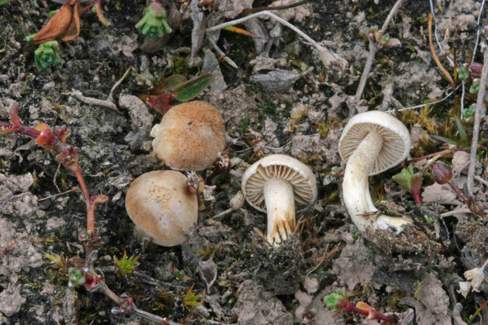 Hebeloma louiseae (Photo: H. J. Beker)
Hebeloma louiseae (Photo: H. J. Beker)Taxonomy
Full name: Hebeloma louiseae Beker, Vesterh. & U.Eberh., Persoonia 35: 127 (2015)Genus: Hebeloma
Section: Denudata
Subsection: Crustuliniformia
Types: SVALBARD: Ossian (78.9261°N, 12.4543°E, alt. approx. 5 m a.s.l.) on grassy, mossy soil in arctic, coastal tundra under Salix polaris, 17 Aug. 2007, H.J. Beker, M.L. Beker (Holotype. herbarium acc. no. BR BR-MYCO 173982-61 (holotype), C C-F-90149 (isotype), HJB12019).
- arrow_drop_downarrow_drop_upEtymologyTo mark the support Louise Beker has provided to this entire project not only with her time but also travelling to remote places in search of Hebeloma spp.
- arrow_drop_downarrow_drop_upDiagnosisHebeloma louiseae was found in arctic conditions in Svalbard and is most similar to H. minus, from which it differs by the less prominent spore ornamentation - O1 or O2 and at most a few spores O3. It differs from other taxa of Hebeloma subsect. Denudata [Hebeloma subsect. Crustuliniformia] occurring in arctic conditions by its small number of complete lamellae (less than 40) in combination with an average cheilocystidium apex width of at least 9 µm.
References
Description
- arrow_drop_downarrow_drop_upThresholds
Description of Hebeloma louiseae based on 10 collections
- arrow_drop_downarrow_drop_upMacroscopic descriptionPileus: 7–18 (22) mm diameter; shape often broadly umbonate, occasionally convex; characters Not recorded; margin characters often smooth, occasionally crenulate; viscosity tacky when moist; colour variation often unicolour, occasionally two color; colour at centre often clay-buff, occasionally yellowish brown.
Lamellae: attachment emarginate; maximum depth up to 2 mm; number of complete lamellae 28–40; presence of tears often absent, occasionally visible with naked eye; white fimbriate edge usually present, occasionally very strong.
Cortina presence: no.
Stipe: (8) 10–21 (25) x 2–3 {median} x 1–3 {basal} mm; stipe Q 4.0–9.2; base shape often cylindrical, occasionally clavate or tapering; floccosity often fibrillose or pruinose, occasionally floccose; rooting no; thick rhizoids at base absent;
Context: Texture firm; stipe interior stuffed; stipe flesh discolouring often yes, occasionally no or weak; slenderness measure 4.8–12.9; smell often odourless, occasionally raphanoid; taste mild where recorded.
Spore deposit colour: greyish brown.
Exsiccata characters: Not recorded.
- arrow_drop_downarrow_drop_upMicroscopic descriptionSpores: shape amygdaloid, rarely limoniform; colour in microscope often brown or yellow brown; guttules often yes, occasionally no. papilla often no, occasionally yes or weak; Spore Code: O1 O2; P0; D1 (D2).
Basidia: (23) 24–52 (56) x 6–11 μm; ave. Q 3.2–4.6; spore arrangement 4 spored;
Cheilocystidia: main shape clavate-stipitate, often capitate-stipitate, rarely clavate-lageniform or clavate-ventricose, spathulate, spathulate-stipitate or subcapitate; special features observed often septa or apical thickening, occasionally bifurcate, rostrate or sinuate; cheilocystidia ratios: A/M = 1.85–2.51; A/B = 1.99–2.92; B/M = 0.81–1.24.
Pleurocystidia: usually none seen, rarely seen.
Ixocutis: epicutis thickness (measured from exsiccata) up to 100 μm; ixocutis hyphae width up to 6 μm; ixocutis hyphae encrustation yes; shape of trama elements beneath subcutis isodiametric or thickly sausage-shaped.
Caulocystidia: Similar to cheilocystidia but larger, up to 75 μm.
- arrow_drop_downarrow_drop_upSpore measurements
- arrow_drop_downarrow_drop_upCheilocystidia measurements
- arrow_drop_downarrow_drop_upHabitat and distributionHebeloma louiseae's preferred habitat appears to be arctic, coastal tundra. Across our collections, Hebeloma louiseae has only been recorded as associating with Salix (family Salicaceae). The growth habit of our collections was scattered.
According to our current data, the species is found on multiple continents with collections found in Europe (50.0%) and Northern America (50.0%). On these continents, collections has been found in the WWF biomes The World Wildlife Fund (WWF) have divided the world into 867 terrestrial ecoregions. The ecoregion here is estimated by mapping from the GPS coordinates of the collection using data made available by Dinerstein et al (2017). Use this webtool to explore the ecoregions visually or see a full list of current ecoregions on Wikipedia. tundra (60.0%) and unknown biome (40.0%), specifically including the ecoregions: Unknown region (40.0%), Kalaallit Nunaat Arctic steppe (40.0%) and Russian Arctic desert (20.0%). From collector information, it appears collections have been found only in the 4.1 Grassland – Tundra IUCN habitat We map from the collector's description of the habitat to the International Union for Conservation of Nature (IUCN)'s definition using a standardised set of rules. Please see this page for a full list of IUCN habitats..
Within Europe all our records are from the North (Svalbard). Specimens have been collected from 77.8°N to 78.9°N.
Within Northern America all our records are from Subarctic America (Greenland).
- arrow_drop_downarrow_drop_upMolecular resultsHebeloma louiseae is not only monophyletic but also receives (high) bootstrap support in five out of six tested loci. Only V9 cannot distinguish it from H. minus (Eberhardt et al. 2015a). The ITS should be suited for species identification. We are not aware of any sequences from outside Europe that are likely to belong to this taxon.
- arrow_drop_downarrow_drop_upCommentaryGiven the shape of its cheilocystidia, Hebeloma louiseae clearly belongs to H. subsect. Crustuliniformia. Hebeloma louiseae has most likely not been included in the intercompatibility tests of (Aanen & Kuyper 1999). We have only seen three collections of this taxon, but we suspect that it is confined to arctic and possible alpine locations. In these habitats, the combination of less than 40 full length lamellae, the large average apex width of the cheilocystidia, greater than 8.5 μm, and the weakly ornamented spores unambiguously define this taxon. The closest taxon with which it might be confused is H. minus, but this has spores that are usually much more distinctly ornamented. Given the small number of collections on which our description is based, it is possible that our description is too narrow, but until more collections of this taxon are recorded, we cannot be sure.
Geographic distribution
Phenology
- arrow_drop_downarrow_drop_upAdditional cited collections